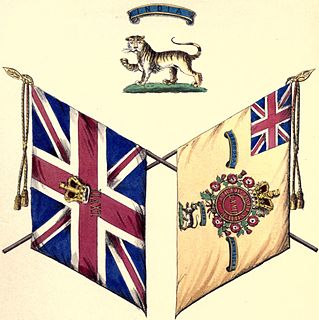This page is based on this
Wikipedia article Text is available under the
CC BY-SA 4.0 license; additional terms may apply.
Images, videos and audio are available under their respective licenses.
The 28th Regiment of Foot was a line infantry regiment of the British Army, raised in 1694. Under the Childers Reforms it amalgamated with the 61st Regiment of Foot to form the Gloucestershire Regiment in 1881.
The 78th Regiment, (Highland) Regiment of Foot also known as the 78th Fraser Highlanders was a British infantry regiment of the line raised in Scotland in 1757, to fight in the Seven Years' War. The 78th Regiment was one of the first three Highland Regiments to fight in North America.

The 55th Regiment of Foot was a British Army infantry regiment, raised in 1755. After 1782 it had a county designation added, becoming known as the 55th (Westmorland) Regiment of Foot. Under the Childers Reforms it amalgamated with the 34th (Cumberland) Regiment of Foot to form the Border Regiment in 1881.
The 38th Regiment of Foot was an infantry regiment of the British Army, raised in 1705. Under the Childers Reforms it amalgamated with the 80th Regiment of Foot to form the South Staffordshire Regiment in 1881.
The 84th Regiment of Foot was a British regiment raised for service in India with the British East India Company.

The 67th Regiment of Foot was a line infantry regiment of the British Army, raised in 1756. Under the Childers Reforms it amalgamated with the 37th Regiment of Foot to form the Hampshire Regiment in 1881.

The 40th Regiment of Foot was an infantry regiment of the British Army, raised in 1717 in Annapolis Royal, Nova Scotia. Under the Childers Reforms it amalgamated with the 82nd Regiment of Foot to form the Prince of Wales's Volunteers in 1881.
The 61st Regiment of Foot was an infantry regiment of the British Army, raised in 1756. Under the Childers Reforms it amalgamated with the 28th Regiment of Foot to form the Gloucestershire Regiment in 1881.
The 64th Regiment of Foot was an infantry regiment of the British Army. The regiment was created as the 2nd Battalion, 11th Regiment of Foot in 1756, redesignated as the 64th Regiment of Foot in 1758, and took a county title as the 64th Regiment of Foot in 1782. Following the Cardwell Reforms the regiment amalgamated with the 98th Regiment of Foot to become The Prince of Wales's in 1881. In the new regiment the 64th Foot became the 1st Battalion due to its seniority over the 98th Foot.
The 87th Regiment of Foot was a Scottish infantry regiment in the British Army, formed in 1759 and disbanded in 1763.
The 48th (Northamptonshire) Regiment of Foot was a regiment of the British Army, raised in 1741. Under the Childers Reforms it amalgamated with the 58th (Rutlandshire) Regiment of Foot to form the Northamptonshire Regiment in 1881.
The 109th (Aberdeenshire) Regiment of Foot was an infantry regiment of the British Army from 1794 to 1795. Raised by Alexander Leith Hay for service in the French Revolutionary Wars the regiment was briefly deployed in Jersey before it was disbanded in England and its men sent to reinforce the 53rd (Shropshire) Regiment of Foot. The disbandment was controversial as Leith-Hay believed it contravened an assurance given to him in his original letter of service to raise the regiment.

The 29th Punjabis was an infantry regiment of the British Indian Army. It was raised in 1857, as the 21st Regiment of Punjab Infantry. It was designated as the 29th Punjabis in 1903 and became 10th (Training) Battalion of 15th Punjab Regiment in 1922. In 1943, it was converted into the 15th Punjab Regimental Centre. In 1947, the 15th Punjab Regiment was allocated to the Pakistan Army. In 1956, the 1st, 14th, 15th and 16th Punjab Regimental Centres where amalgamated to form the Punjab Regimental Centre.

The 22nd Punjabis was an infantry regiment of the British Indian Army. It was raised in 1857, as the 11th Regiment of Punjab Infantry. It was designated as the 22nd Punjabis in 1903 and became 3rd Battalion 14th Punjab Regiment in 1922. In 1947, it was allocated to the Pakistan Army, where it continues to exist as 7th Battalion The Punjab Regiment.
The 89th (Highland) Regiment of Foot or Morris's Highlanders was an infantry regiment in the British Army from 1759 to 1765.
The 85th Regiment of Foot was a short-lived infantry Regiment in the British Army which was raised in 1777 to provide garrison troops for the West Indies during the American Revolutionary War.
The 90th Regiment of Foot was a short-lived infantry regiment in the British Army which was raised in Ireland as a light infantry corps in 1759, during the Seven Years' War with France.




